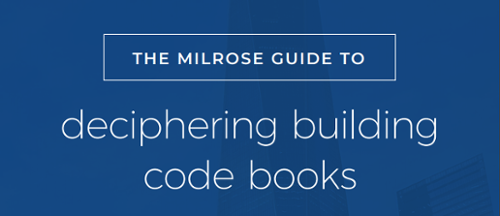Deciphering building code books is no easy task. These regulatory tomes are dense and stuffed with complex technical language. To further complicate matters code books are updated and amended frequently. That said, design and building professionals have no choice but to dive headfirst into code books in order to ensure their building plans meet compliance.
However, with some insight into how code books are written and organized, readers can effectively navigate them and find the guidance they need to accurately determine and apply the applicable building code requirements to their project.
The basics
Understanding the unique language found in code books is essential to being able to interpret and apply the building code correctly. There are some basic grammatical conventions that tend to appear in almost all regulatory guides. These items include:
- Semantics: Code books contain seemingly familiar words. However, many have special definitions within the context of building codes. Why? Regulatory bodies have determined that the dictionary-driven explanations associated with these terms are too broad. As an example, the word "shall," which Merriam-Webster Dictionary says is "used to express what is inevitable or seems likely to happen in the future," should be interpreted as a stand-in for "mandatory" in code books.
- Conjunctions: Common conjunctions like "and" and "or" also take on new meanings when used in code books. "And" is normally used with two code requirements, meaning both apply. "Or" is typically deployed in the same way but means that just one of the listed code requirements applies.
- Citations: Code books feature the following common citation types; prescriptive, implied, interpretive, contradictory and in some cases inaccurate. Readers must be able to identify the type of citation they are reading and use the contextual frameworks that accompany them to unpack actionable insights.
By getting a handle on these basics, design and building professionals can more effectively decipher the building code provisions within code books.
The steps in code analysis
Although knowing code books' idiosyncratic language makes understanding them easier, grasping the text constitutes just half the equation. On top of interpreting the words on the page, readers need to know how to contextualize the copy against related regulations. As mentioned above, code books sometimes include statutes that seem set-in-stone but are actually contradicted or superseded in other places.
To prevent the obvious problems that could arise as a consequence of in-text discrepancies, it is important for readers to perform a comprehensive code analysis, which involves:
- Following code book pathways: This entails cross-referencing specific items across multiple chapters to ensure code accuracy. For instance, a reader looking to understand the fire protection requirements for an atrium might need to reference text within sections on interior finishes and means of egress to understand the full scope of the requirements.
- Deconstructing provisional hierarchies: Most of the regulations contained within code books feature general and specific provisions. The former usually set general standards while the latter tackle distinct contexts in which the former might be applied. This setup can lead to contradictions or instances of overruling. For example, a general provision might dictate that egress doors swing in the direction of traffic flow for rooms with occupant loads of 50 or higher, while a specific provision adds that this rule applies to machinery rooms 1,000 square feet or larger, no matter the occupant load. Therefore, it is important to keep in mind that a general provision can be superseded by specific provision.
This sort of pragmatic analysis is key to performing a successful comprehensive code analysis.
The importance of interpreting code books properly
The importance of effective code book interpretation cannot be overstated. Knowing how to properly read and navigate code books will enable you to design to code-compliance and therefore avoid costly project slowdowns or noncompliance penalties.
John James Secreti, R.A. put together a resource that expands on the information above as a way to provide additional value to our clients. John is a New York State Code Enforcement Official who boasts extensive experience in the interpretation and application of code and zoning laws across multiple jurisdictions.
Click the button above to download our latest ebook "The Milrose guide to deciphering building code books".
If you need additional help solving a code problem, turn to our experts. Learn about our services or Request a proposal to schedule time with our experienced code and zoning analysts.








